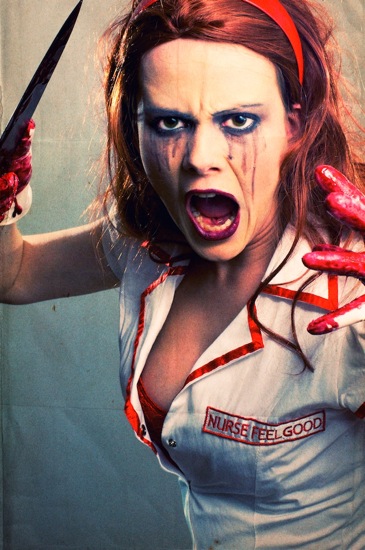JASON LISKE
Nexus (Camosun College)
VICTORIA (CUP) ”“ Even the most cursory glance through the history of horror films shows helpless women fleeing in terror from masked killers and rampaging monsters, fainting helplessly into the arms of the men who save them.
But at a certain point in horror’s history, things changed and, typically, one woman survived in each movie.
“If you look at the entire history of the genre then, yes, women’s roles have changed greatly,” said Ben Scrivens, creator of the horror-shirt company Fright Rags. “In the early days, the role of women in horror films was primarily the victim. It wasn’t until the liberated ’60s and ’70s that you started seeing the woman as a warrior or survivor.”
This female survivor is often referred to as the “final girl” — a staple of slasher films, especially those made in the ’70s and ’80s. Often enough, they are stereotypical “good girls” and are usually the only characters that refrain from the proverbial sex, drugs and rock ‘n’ roll.
These aspects often enforce a negative, subconscious notion that a woman who is sexually active deserves chastisement in some form.
Not everyone agrees with that, however.
“While most genre films of the ’80s depicted women in a very one-dimensional way — for example, girls looking to party — most of them also featured one strong woman that ended up defeating the killer at the end of the film,” said Scrivens. “I’ve always felt that was showcasing women in a positive way.”
But most horror films tend to show women firmly set in the role of screaming victim, and female monsters are few and far between. The 1930s horror films such as Bride of Frankenstein, Vampyr and Island of Lost Souls, however, have female villains of some sort.
In the 1940s, Val Lewton’s Cat People was a catalyst for a certain notion of feminism to creep into the horror genre. Here, female sexuality is presented as mysterious and dangerous through the character of the cat-woman, Irena. Reflecting male fears of assertive female sexuality, Irena is turned into a savage panther at the slightest kiss or arousal of jealous emotion. According to some, this may not be as progressive as it seems.
“I find this troubling because it highlights the idea that women are still viewed as far more corporeal than men; that women’s personalities are fundamentally tied into their bodies,” said Bronwen Welch, who teaches English at Camosun College in Victoria, B.C. “Woman is still object, whether she is victim or murderer.”

In Roman Polanski’s progressive psychological horror film Repulsion, a young woman is both victim and murderer — chased by sexually aggressive males, she suffers from a deep-seated fear of sex and becomes a razor-wielding killer in order to defend herself.
Recently, several horror films have been released that use the idea of the female body as a mysterious source of fear in a much more subversive way. Teeth and Ginger Snaps are two good examples. Both films take a cue from horror classic Carrie, supplementing its ideas with a vicious sense of humour in their approach to female biology and society’s irrational fears of it.
In Teeth, a young woman defends herself from unwanted sexual advances through the use of shark-like teeth inside her vagina. Not only does this portray an ancient myth of men’s primal fears associated with women, but it also subversively mocks the idea that the female vagina is something to be feared.
Ginger Snaps, on the other hand, uses the idea of transforming into a werewolf as a metaphor for female puberty.
“The film focuses on the fact that Ginger’s transformation coincides with the fact that she has just started menstruating,” Welch said. “The movie is thus a subversive attack on the whole genre that represents female sexuality as either violent and disturbing or passive and suffering.”
The idea of the monstrous feminine is not always so over-the-top. Grueling films such as Hard Candy, indie classic May and the Japanese film Audition have all contributed to the cliché idea of a scorned woman exacting bloody revenge.
In Hard Candy, a young teenage girl lures a pedophile to his doom, acting as a sort of angel of retribution for the souls of those he has hurt and killed.
Audition and May take an entirely different approach by subverting societal expectations of the “perfect female,” with Audition focusing on Japanese culture. What results is some of the most gruesome and disturbing footage ever filmed.
Some horror films have eschewed the idea of the female monster altogether in favour of women being portrayed as strong, independent and more than capable of standing up to their antagonists without being villains.
The Alien series, especially the second movie in the series, Aliens, has become somewhat of a feminist touchstone with its character of Lt. Ellen Ripley. The Aliens theatrical poster emphasizes this, showing her as both masculine warrior and feminine mother standing up to hordes of phallic alien creatures.
More recently, the British film The Descent depicts women who are stronger and more ferocious than the terrifying subterranean creatures they are up against.
Unfortunately, for every Teeth, there’s soft-porn trash like Species. And with recent horror remakes such as Prom Night and Friday the 13th, women are again being portrayed as airbrushed bimbos ready for slaughter.
But with modern films like The Descent and Teeth, women’s portrayal in horror film is definitely on the upswing. Let’s hope it stays that way.
– –
image: Flickr / Stu Willis